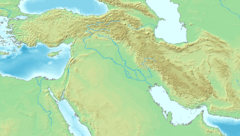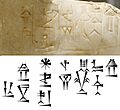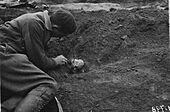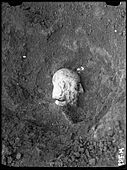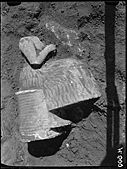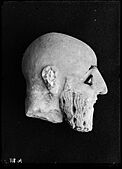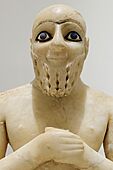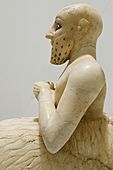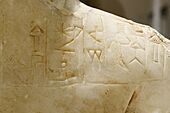Statue of Ebih-Il facts for kids
Quick facts for kids Statue of Ebih-Il |
|
|---|---|
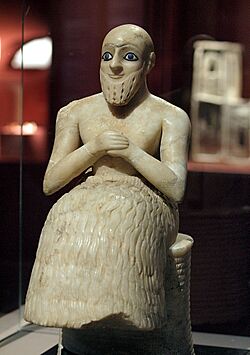
Statue of Ebih-Il, superintendent of Mari
|
|
| Material | Alabaster, shells, lapis lazuli, bitumen |
| Height | 52.5 centimetres (20.7 in) |
| Width | 20.6 centimetres (8.1 in) |
| Depth | 30 centimetres (12 in) |
| Created | c. 2400 BC |
| Period/culture | Sumerian |
| Discovered | 1934 |
| Place | Temple of Ishtar, Mari, Syria |
| Present location | Musée du Louvre, Paris Heilongjiang Art Museum, Harbin (downsized replica) |
| Identification | AO 17551 |
|
Location in Near East
|
|
The Statue of Ebih-Il is a very old statue, made about 4,500 years ago! It shows a man named Ebih-Il (which means "my god is good"). He was an important leader, a "superintendent," in the ancient city of Mari. Mari was a powerful city-state in what is now eastern Syria.
Archaeologists found this statue in 1934 at the Temple of Ishtar in Mari. A French team led by André Parrot made this amazing discovery. The statue is crafted from gypsum, a soft stone, and decorated with shiny schist, shells, and bright blue lapis lazuli. Today, you can see this incredible artwork at the Musée du Louvre in Paris, France. Many people think it's a true masterpiece because of how well it was made and how good it still looks.
Contents
What the Statue Looks Like
This statue is carved from smooth, see-through alabaster stone. It shows a man sitting on a wicker stool. His hands are pressed together against his chest, like he is praying or showing respect to a god.
The Face and Eyes
The man's head is shaved, but he has a long beard made of curly lines. There are tiny holes in his beard where other materials might have been placed long ago, but they are now gone. His beard makes his cheeks and lips stand out. He has a small, gentle smile.
His blue eyes are very special and detailed. They are made from different materials:
- Dark schist forms the eyelashes and eyelids.
- White shells create the white part of his eyes (the cornea).
- Bright blue lapis lazuli makes up the colored part of his eyes (the iris).
The lapis lazuli stone came from far away, possibly even from Afghanistan!
The Body and Clothing
The statue shows the man's bare chest and a thin waist. His hands are clasped together, with his left hand resting inside his right.
He wears a special skirt called a kaunakes skirt. This type of skirt was popular in ancient Sumer. It looks like it's made from animal hide, probably sheepskin or goatskin, because it even has a small tail at the back! The statue's feet are missing, but you can still see where they would have been attached under his skirt.
The Secret Message
On the back of the statue, there's a message written in an ancient script called proto-cuneiform. This writing tells us who the statue is of and why it was made. It says: "Statue of Ebih-Il, the superintendent, dedicated to Ishtar Virile." This means Ebih-Il gave this statue as a gift to the goddess Ishtar.
dul, Ebih-il, nu-banda, dIštar Nita, sarig
"This statue, Ebih-il, the overseer, to Ishtar (?), he dedicated"—Inscription on the statue of Ebib-Il.
How the Statue Was Found
A French team of archaeologists, led by André Parrot, found the statue in two main pieces.
- The head was discovered first, on January 22, 1934, lying on the floor of the Temple of Ishtar's outer courtyard.
- The very next day, January 23, 1934, the rest of the body was found just a few meters away.
They also found a smaller statue of King Lamgi-Mari nearby.
When it was found, the statue had some damage. The left arm and elbow were broken, and the base of the right elbow was shattered. These statues were the first big discoveries made during the Mari excavations, which had just started in the winter of 1933.
More Details of the Statue
See also
- Art of Mesopotamia
- Investiture of Zimrilim
- Statue of Iddi-Ilum


